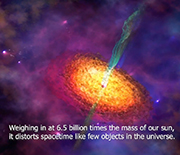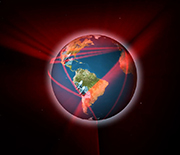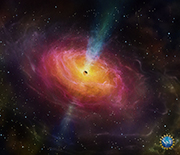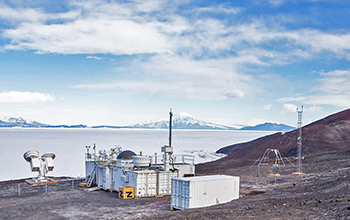
News Release 19-006
National Science Foundation and Event Horizon Telescope contribute to paradigm-shifting observations of the gargantuan black hole at the heart of distant galaxy Messier 87
April 10, 2019
Update: The members of the Event Horizon Telescope Collaboration were awarded the Breakthrough Prize in Fundamental Physics on Sept. 5, 2019. The Breakthrough Prize annually recognizes achievements in science and mathematics.
Watch the National Science Foundation/EHT Press Conference Revealing First Image of Black Hole
For additional information and media resources, please visit: NSF Exploring Black Holes.
The Event Horizon Telescope (EHT) — a planet-scale array of eight ground-based radio telescopes forged through international collaboration — was designed to capture images of a black hole.
Today, in coordinated press conferences across the globe, EHT researchers reveal that they have succeeded, unveiling the first direct visual evidence of a supermassive black hole and its shadow.
This breakthrough was announced in a series of six papers published in a special issue of The Astrophysical Journal Letters. The image reveals the black hole at the center of Messier 87, a massive galaxy in the nearby Virgo galaxy cluster. This black hole resides 55 million light-years from Earth and has a mass 6.5-billion times that of the Sun.
“This is a huge day in astrophysics,” said NSF Director France Córdova. “We’re seeing the unseeable. Black holes have sparked imaginations for decades. They have exotic properties and are mysterious to us. Yet with more observations like this one they are yielding their secrets. This is why NSF exists. We enable scientists and engineers to illuminate the unknown, to reveal the subtle and complex majesty of our universe.”
The EHT links telescopes around the globe to form an Earth-sized virtual telescope with unprecedented sensitivity and resolution. The EHT is the result of years of international collaboration and offers scientists a new way to study the most extreme objects in the Universe predicted by Einstein’s general relativity during the centennial year of the historic experiment that first confirmed the theory.
“We have taken the first picture of a black hole,” said EHT project director Sheperd S. Doeleman of the Center for Astrophysics | Harvard & Smithsonian. “This is an extraordinary scientific feat accomplished by a team of more than 200 researchers.”
The National Science Foundation (NSF) played a pivotal role in this discovery by funding individual investigators, interdisciplinary scientific teams and radio astronomy research facilities since the inception of EHT. Over the last two decades, NSF has directly funded more than $28 million in EHT research, the largest commitment of resources for the project.
Black holes are extraordinary cosmic objects with enormous masses but extremely compact sizes. The presence of these objects affects their environment in extreme ways, warping spacetime and super-heating any surrounding material.
“If immersed in a bright region, like a disc of glowing gas, we expect a black hole to create a dark region similar to a shadow — something predicted by Einstein’s general relativity that we’ve never seen before,” explained chair of the EHT Science Council Heino Falcke of Radboud University, the Netherlands. “This shadow, caused by the gravitational bending and capture of light by the event horizon, reveals a lot about the nature of these fascinating objects and allowed us to measure the enormous mass of M87’s black hole.”
Multiple calibration and imaging methods have revealed a ring-like structure with a dark central region — the black hole’s shadow — that persisted over multiple independent EHT observations.
“Once we were sure we had imaged the shadow, we could compare our observations to extensive computer models that include the physics of warped space, superheated matter and strong magnetic fields. Many of the features of the observed image match our theoretical understanding surprisingly well,” remarks Paul T.P. Ho, EHT Board member and Director of the East Asian Observatory. “This makes us confident about the interpretation of our observations, including our estimation of the black hole’s mass.”
Creating the EHT was a formidable challenge that required upgrading and connecting a worldwide network of eight pre-existing telescopes deployed at a variety of challenging high-altitude sites. These locations included volcanoes in Hawai`i and Mexico, mountains in Arizona and the Spanish Sierra Nevada, the Chilean Atacama Desert, and Antarctica.
The EHT observations use a technique called very-long-baseline interferometry (VLBI). which synchronizes telescope facilities around the world and exploits the rotation of our planet to form one huge, Earth-size telescope observing at a wavelength of 1.3mm. VLBI allows the EHT to achieve an angular resolution of 20 micro-arcseconds — enough to read a newspaper in New York from a sidewalk café in Paris.
The telescopes contributing to this result were ALMA, APEX, the IRAM 30-meter telescope, the James Clerk Maxwell Telescope, the Large Millimeter Telescope Alfonso Serrano, the Submillimeter Array, the Submillimeter Telescope, and the South Pole Telescope. Petabytes of raw data from the telescopes were combined by highly specialized supercomputers hosted by the Max Planck Institute for Radio Astronomy and MIT Haystack Observatory.
The construction of the EHT and the observations announced today represent the culmination of decades of observational, technical, and theoretical work. This example of global teamwork required close collaboration by researchers from around the world. Thirteen partner institutions worked together to create the EHT, using both pre-existing infrastructure and support from a variety of agencies. Key funding was provided by the US National Science Foundation, the EU’s European Research Council (ERC), and funding agencies in East Asia.
“We have achieved something presumed to be impossible just a generation ago,” concluded Doeleman. “Breakthroughs in technology, connections between the world’s best radio observatories, and innovative algorithms all came together to open an entirely new window on black holes and the event horizon.”
-NSF-
-
View VideoIf you could fly next to the supermassive black hole M87*, this is what you would see.
Credit and Larger Version -
View VideoANIMATION – forming an Earth-size telescope – 10 second version
Credit and Larger Version -
View VideoBRIEF, SELF-CONTAINED, NARRATED OVERVIEW of Event Horizon Telescope project and the first black hole
Credit and Larger Version -
If you could fly next to the supermassive black hole M87*, this is what you would see.
Credit and Larger Version -
Top-down view of accretion disk around black hole at center of M87.
Credit and Larger Version -
The paths of photons are bent by the gravity of the black hole at the center of M87
Credit and Larger Version
PAPERS:
- Paper I: The Shadow of the Supermassive Black Hole
- Paper II: Array and Instrumentation
- Paper III: Data processing and Calibration
- Paper IV: Imaging the Central Supermassive Black Hole
- Paper V: Physical Origin of the Asymmetric Ring
- Paper VI: The Shadow and Mass of the Central Black Hole
ADDITIONAL QUOTES:
- Dimitrios Psaltis, University of Arizona in Tucson, EHT project scientist
“The size and shape of the shadow matches the precise predictions of Einstein’s general theory of relativity, increasing our confidence in this century-old theory. Imaging a black hole is just the beginning of our effort to develop new tools that will enable us to interpret the massively complex data that nature gives us.” - Colin Lonsdale, Director of MIT Haystack Observatory
“What really made this realistic as a science goal was technology provided by the computing world, which finally caught up, and overtook, costly custom-built instrumentation. Haystack adapted newly available high-capacity hard disk drives and fast, flexible processor chips, and designed them into systems that could be used for VLBI. Once that key transition had occurred, successive generations of the systems could readily take advantage of industry-driven performance increases over time, and after more than a decade, the prodigious recording and processing speeds demanded by the EHT and black hole imaging were made a reality.” - Tony Beasley, director of NSF’s National Radio Astronomy Observatory
“Through its leadership in ALMA and long-term support for the EHT, NRAO has once again helped to advance our understanding of the cosmos and the fundamental laws physics. This observation clearly illustrates the value of radio astronomy to scientific advancement. The next generation of radio telescopes, including the Next Generation VLA, will yield many more groundbreaking results.”
Media Contacts
NSF Public Affairs, NSF, 703-292-8070, email: media@nsf.gov
The U.S. National Science Foundation propels the nation forward by advancing fundamental research in all fields of science and engineering. NSF supports research and people by providing facilities, instruments and funding to support their ingenuity and sustain the U.S. as a global leader in research and innovation. With a fiscal year 2020 budget of $8.3 billion, NSF funds reach all 50 states through grants to nearly 2,000 colleges, universities and institutions. Each year, NSF receives more than 40,000 competitive proposals and makes about 11,000 new awards. Those awards include support for cooperative research with industry, Arctic and Antarctic research and operations, and U.S. participation in international scientific efforts.
![]() Get News Updates by Email
Get News Updates by Email
Connect with us online
NSF website: nsf.gov
NSF News: nsf.gov/news
For News Media: nsf.gov/news/newsroom
Statistics: nsf.gov/statistics/
Awards database: nsf.gov/awardsearch/
Follow us on social
Twitter: twitter.com/NSF and twitter.com/NSFspox
Facebook: facebook.com/US.NSF />
Instagram: instagram.com/nsfgov













